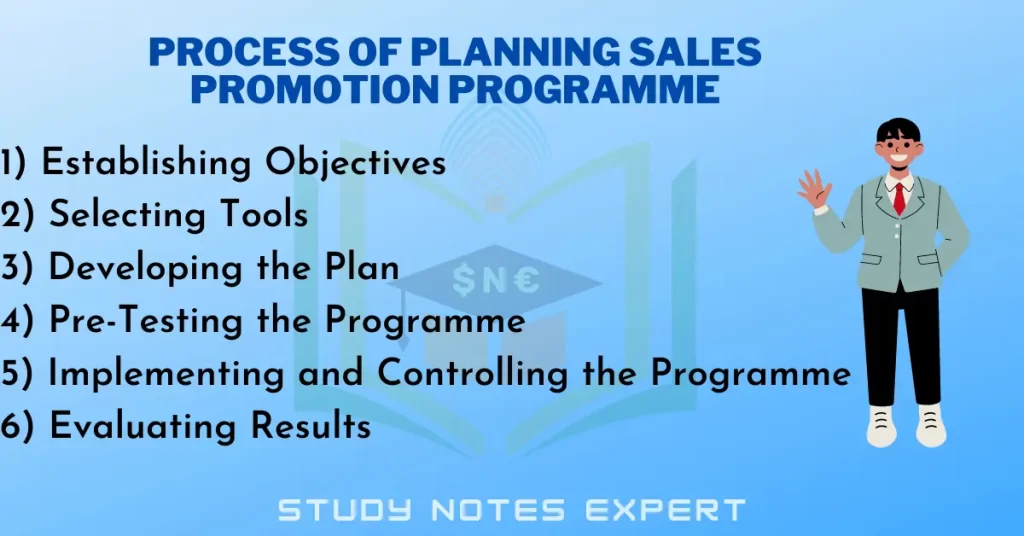Any action focused towards enhancing sales and usage or trial of a product or service is called ‘sales promotion’. It fills the area not covered by any other marketing communication or promotion mix element. In the following section, you will know the process of planning sales promotion Programme.
There are different types of sales promotion, and each is given importance, depending on the circumstances or situations, like:
1) Consumer-based sales promotion is used to enhance the sale of seasonal products during off-seasons.
2) Middlemen or channel-based sales promotion’ is used when the middlemen or distribution channel intermediaries are closer to customers than the original manufacturers.
3) Salesmen-based sales promotion motivates salespeople when the focus is to remove old inventory.
Process of Planning Sales Promotion Programme

Marketers use different types of media in any sales promotion plan. A typical sales promotion plan includes the following steps:
1) Establishing Objectives
The first step process of planning sales promotion Programme is establishing sales promotion objective(s). Product-related marketing, as well as promotion objectives, help in designing the sales promotion objectives. Different sales promotion objectives are established for different target markets. For example, sales promotion objectives established for consumers may include prompting bulk purchases (or purchasing large units), getting switchers back and encouraging nonusers to purchase organizational products and services.
2) Selecting Tools
In the second step of process of planning sales promotion Programme, promotion tools are selected per the sales promotion objective(s). Different promotion tools are as follows:
i) Consumer-Promotion Tools
The promotion market planner selects tools targeted at consumer promotion. Factors like expense, target competitive conditions and sales promotion objectives are considered for suitable tool selection.
ii) Trade-Promotion Tools
According to the objective, most of the time, trade promotion tools are selected by the promotion planner. In a particular sales promotion pie chart, the largest section covers trade promotion tools, whereas consumer promotion tools and media advertising covers the rest.
iii) Business and Sales Force Promotion Tools
To fulfil certain business and sales force-related promotion objectives like collecting leads, motivating the sales force to improve its performance and impressing and rewarding customers, organizations generally use business and sales force promotion tools. The organization designs an annual budget for different business promotion tools. Thus, billions of rupees are spent on designing and utilizing such tools.
3) Developing the Plan
The next step process of planning sales promotion Programme is devoted to the development of a sales promotion plan. The following factors should be considered while developing the sales promotion plan:
i) Size
Determining the size of the promotion tool is crucial for effective sales promotion. An appropriate promotion size is required for successful sales promotion as using a huge promotion tool may lead to improved sales but with fading rate.
ii) Conditions
It is also essential to draw the conditions for consumers to avail of such promotion tools. It may be targeted at every individual or some specific person or group. A person or group with UPCs (or proof-of-purchase seals) may avail of promotion premiums.
iii) Duration
The promotion planner should also decide the appropriate duration of the sales promotion tool(s). It should not be too short (so that most prospects remain unserved) or for long (so that it diminishes its value).
iv) Distribution Vehicle
A distribution vehicle must also serve consumers with sales promotion tools. The promotion planner must select a suitable distribution vehicle (according to cost, the extent of reach and the effect) for each promotion tool. For example, a simple mail and advertisements package of the product or even the store may be used as a distribution vehicle to offer a fifteen percent off coupon.
v) Timing
The timing of offering a particular sales promotion is also considered before finalizing the sales promotion plan. For example, different calendar dates are selected by brand managers to offer sales promotion tools and production, sales and distribution departments of the organization manage their operations as per these dates.
vi) Sales-Promotion Budget
The last factor considered while developing the sales promotion plan is the budget of the sales promotion. This budget may be developed by estimating the cost individually or collectively. The sum of promotion tool cost (like cost incurred on discounts or premiums) and administrative cost (like the cost of mailing, printing and communicating) is multiplied by the possible number of units to be sold to determine the total cost of the promotion.
4) Pre-Testing the Programme
After developing a sales promotion plan for the process of planning sales promotion Programme, it is essential to pre-test it. Although a list of factors is considered while developing the plan, the pre-test highlights its merits and demerits. Several aspects of the promotion tool, like its size, distribution method, suitability, etc., are analyzed with the help of a pre-test.
5) Implementing and Controlling the Programme
The next step of process of planning sales promotion Programme includes formulating an implementation and control plan to manage every sales promotion tool. Two important aspects, i.e., lead time and sell-in time, are covered under the implementation plan. Lead time is the time elapsed in developing the sales promotion plan before its launch. It starts from initial planning and lasts until final distribution to the dealer.
It involves several important happenings (designing and selecting package materials, finalizing promotion and sale materials, informing and preparing salespersons, allocating distributors and producing inventories). The time elapsed from the launch of the sales promotion tool to the sale of approximately ninety-five per cent of the promoted product to the consumer is known as Sell-in time.
6) Evaluating Results
The last step of the sales promotion plan includes the evaluation of the sales promotion effectiveness. Sales data, experiments and consumer surveys are mainly used to evaluate sales promotion effectiveness. The findings must be shared with all the participants.

